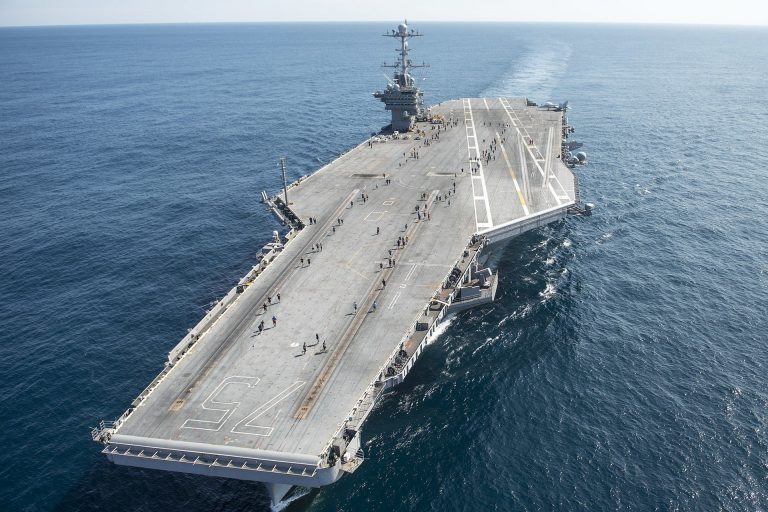The Chinese People’s Liberation Army (PLA) has been continuing to practice targeting U.S. naval vessels with its anti-ship ballistic missiles, as new satellite images obtained by USNI News show a number of silhouettes representing warships in Western China’s Taklamakan desert.
The images are the second such batch since a similar trough of photos were reported on last November. The targets take the shape of ships typically found in the U.S. Navy, including destroyers and aircraft carriers.
The PLA has been boosting its naval capabilities in recent years, with many warships launching into service in recent years. While the PLA Navy is not able to directly match its U.S. counterpart, it has poured resources into asymmetrical ways of checking American maritime prowess, particularly with its anti-ship ballistic missiles.
This focus on anti-shipping ability corresponds with the ship shapes spotted in the large-scale target ranges along the eastern edge of the Taklamakan Desert, which is where the Chinese regime tests its missiles.
RELATED:
- Putin Facing a Mountain of Crippling Sanctions Following Invasion of Ukraine
- Russia and China Escalate Maritime Military Exercises
- Russia and China Hold First-Ever Joint Patrol in the Western Pacific
- Russian Invasion of Ukraine Casts an Ominous Shadow Over Taiwan
USNI’s report also revealed that approximately eight miles southwest of an elaborate aircraft carrier layout, another site with full-scale piers and a “destroyer-sized ship-like target” had completed construction in December last year.
Success
You are now signed up for our newsletter
Success
Check your email to complete sign up
After a test missile struck the ship’s replica sometime in February, however, the target was quickly disassembled and disappeared from recent satellite imagery. Several of the target practices appeared to be naval, while another two had layouts seemingly modeled to replicate ships docked in port, USNI’s report said, adding that high-resolution images were provided by Maxar Technologies.
These targets were discovered as part of All Source Analysis (ASA)’s research into aircraft carrier targets. Based out of Colorado, ASA provides comprehensive geospatial intelligence utilizing cutting edge technology for enterprises and government sources that require “key insights and informed decisions affecting infrastructure, resources and lives.”
How do China’s warships square up?
Last year, China launched its Type 055 large destroyer with a displacement capability of more than 10,000 tons, making up for the extended lack of cruisers in the surface warfare fleet.
The PLA’s 055 Nanchang, which participated in the first joint Sino-Russian naval exercises in October of last year, has also raised alarms over the PLA’s growing combat capabilities. In addition to the Nanchang ship, China sent a Type 052D destroyer and two Type 054A frigates to the military exercise that took place in the Sea of Japan. The naval drill involved a total of 10 warships, five from each nation, and covered over 1,700 nautical miles.
Some commentators have also pointed out that the Chinese fleet may be even more potent than Russia’s lineup. Russia’s two new 20380 corvettes, which have been in service for the last few years, can only be used near the sea, while China’s two 054A frigates can operate in the far ocean.
The PLA has reportedly also been developing several anti-ship ballistic missiles (ASBM). The DF-21D and DF-26 are both land based, while another unknown designation type missile is carried by the H-6 bomber. USNI confirmed that the Type-055 Renhai-class cruiser can launch a smaller missile, provisionally identified as the YJ-21.
Could China be practicing to launch its own invasion?
After Russian forces launched their invasion of Ukraine on Feb. 24, some experts have drawn parallels between the Russia-Ukraine conflict, and the growing tension emerging from Taiwan and mainland China.
Russia’s invasion has led to concerns that the People’s Republic of China (PRC) — which claims Taiwan as a rightful part of its territory, and has vowed to reclaim it by any means necessary — may be emboldened to launch its own military campaign to reclaim the self-ruling island.














